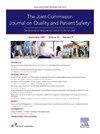A Remote Patient Management Care Model for Pediatric Home Care Ventilator Patients Conserves Resources: A Quality Improvement Initiative
IF 2.4
Q2 HEALTH CARE SCIENCES & SERVICES
Joint Commission journal on quality and patient safety
Pub Date : 2025-06-20
DOI:10.1016/j.jcjq.2025.06.002
引用次数: 0
Abstract
Background
Children’s Hospital of Philadelphia’s Home Care respiratory therapy patient population becomes more acute and resource-intense each year. The organization's trach/vent patients have numerous clinical and equipment needs requiring complex home respiratory management. To conserve respiratory therapy resources, a remote patient management (RPM) program was integrated into the current respiratory services care model by introducing innovative technology to monitor patient data remotely. The authors expected this to reduce the number of home visits defined in the established program while maintaining safe, high-quality care. The goal was a reduction of 20%.
Methods
Biweekly, respiratory therapists (RTs) reviewed electronic health records and equipment downloads for specific patients and contacted them to assess their clinical status. RTs documented findings, planned interventions, communicated with interdisciplinary teams, and determined follow-up. Home and video contacts remained options for concerns. At minimum, RTs assessed patients in homes every three months. Chart reviews and safety rounds supported quality assessment.
Results
Results revealed a 38.7% reduction in home visits compared to the prior year and 59.6% reduction in home visits from pre–COVID-19 baseline data, with several instances of special cause variation observed on statistical process control analysis (p < 0.05). The authors found a 21.01% reduction in on-call volume for ventilator-related issues (p = 0.2) and a 5.8% increase in patient’s status changing to lower acuity (p = 0.2); neither was statistically significant due to low sample size. Results showed time and mileage savings, improved communication with interdisciplinary teams and families, improved RT quality of life, active ventilator weaning for relevant patients, and potential prevention of hospital admissions.
Conclusion
The program delivered innovation to an established care model, providing resource conservation, financial savings, and patient and staff satisfaction, and exceeded its goal.
儿童家庭护理呼吸机患者的远程患者管理护理模式节约资源:质量改进倡议。
背景:费城儿童医院的家庭护理呼吸治疗患者人口每年变得更加急性病和资源紧张。该组织的气管/通气患者有许多临床和设备需求,需要复杂的家庭呼吸管理。为了节约呼吸治疗资源,通过引入创新技术来远程监测患者数据,将远程患者管理(RPM)程序集成到当前的呼吸服务护理模式中。作者期望这能减少既定项目中家访的次数,同时保持安全、高质量的护理。目标是减少20%。方法:每两周,呼吸治疗师(RTs)审查特定患者的电子健康记录和设备下载,并与他们联系以评估他们的临床状况。RTs记录研究结果,计划干预措施,与跨学科团队沟通,并确定随访。家庭和视频联系仍然是人们关注的选择。rt至少每三个月对患者进行一次家庭评估。图表审查和安全轮支持质量评估。结果:结果显示,与前一年相比,家访次数减少了38.7%,与covid -19前基线数据相比,家访次数减少了59.6%,统计过程控制分析中观察到若干特殊原因变化(p < 0.05)。作者发现,呼吸机相关问题的随叫随到量减少了21.01% (p = 0.2),患者状态变为低视力的人数增加了5.8% (p = 0.2);由于样本量小,两者均无统计学意义。结果显示节省了时间和里程,改善了与跨学科团队和家庭的沟通,改善了RT的生活质量,相关患者的主动呼吸机脱机,并可能预防住院。结论:该项目对现有的护理模式进行了创新,节约了资源,节省了资金,提高了患者和工作人员的满意度,并超额完成了目标。
本文章由计算机程序翻译,如有差异,请以英文原文为准。
求助全文
约1分钟内获得全文
求助全文
来源期刊

Joint Commission journal on quality and patient safety
HEALTH CARE SCIENCES & SERVICES-
CiteScore
3.80
自引率
4.30%
发文量
116
审稿时长
49 days
 求助内容:
求助内容: 应助结果提醒方式:
应助结果提醒方式:


